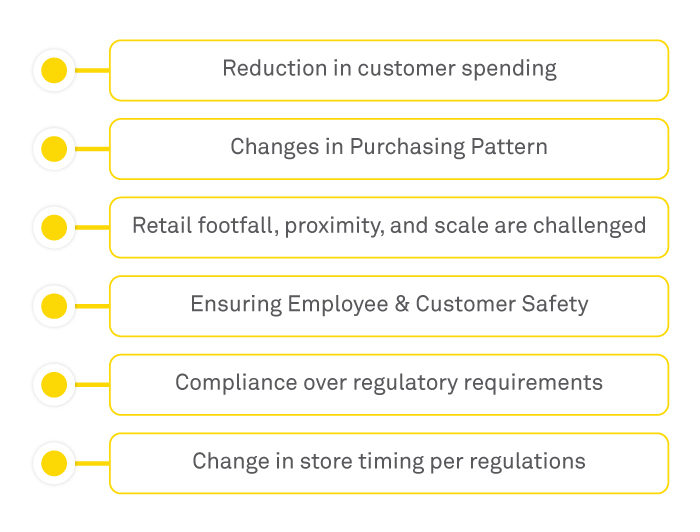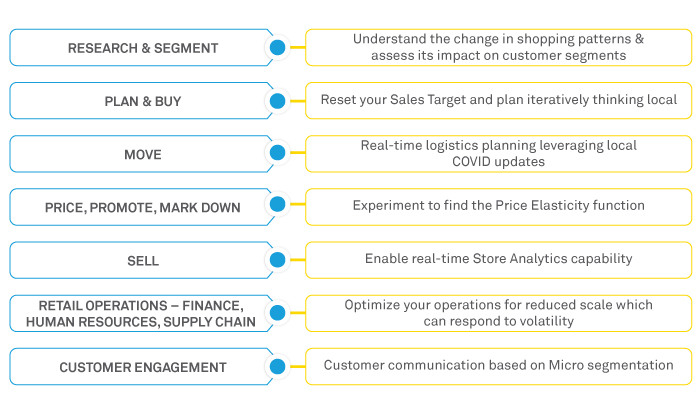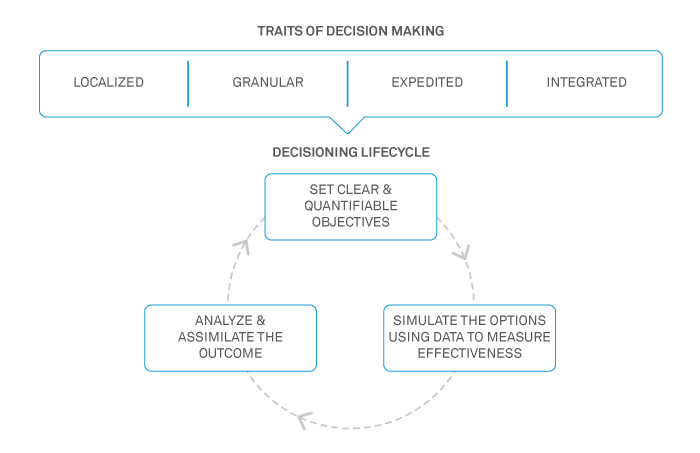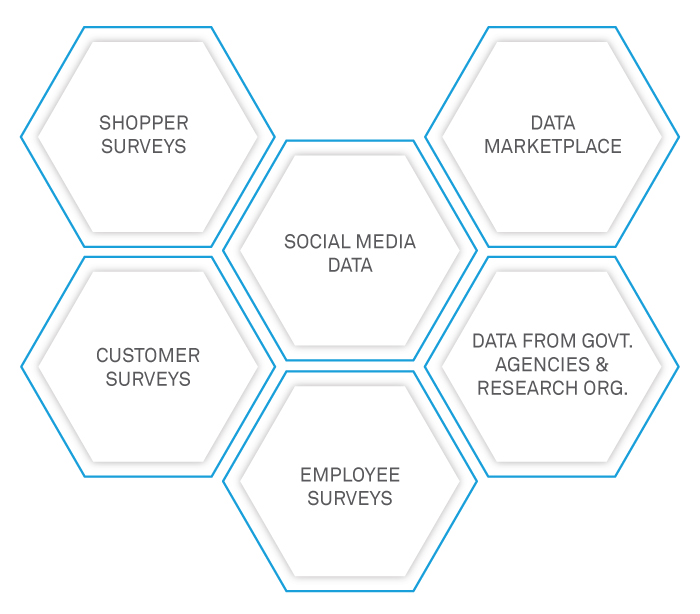While COVID-19 has had a catastrophic impact on health and the economy, it has also fundamentally changed how people live and work in the foreseeable future. Successful retailers often take great pride in their deep understanding of the consumer’s psyche and buying behaviour. In the last decade or so, they have leveraged troves of data for successful decision-making. However, such institutional knowledge has lost its relevance in a matter of few weeks.
Each part of a retailer’s value chain is impacted. Let’s first talk about customers and demand. The first major shift is the decline in consumer spending owing to uncertainties in the job. A recent survey by London Business School indicates that household spending has declined by almost 40-50% [1] in the UK, and similar trends are emerging across the globe. This will have a significant impact on the Retail industry overall. Similarly, the ‘Work from Home’ model will impact the Fashion and Hospitality business.
The economies of scale that big-box retailers leveraged have been constrained to a large extent. Retailers would have to learn to optimize their operations in order to maintain their bottom-line. Density or footfall used to be the key measure in brick-and-mortar retailing. Most retailers measure the efficiency of stores by sales per sq. ft. This will change to comply with government guidelines and ensure safety. Customer and Patient safety and compliance related to public health are added to day-to-day operations.

Figure: 1 – Impact of COVID on the retail industry
These uncertainties have made demand functions and operations strategies void. Since the past is no longer the best predictor of the future, retailers need to start afresh and learn from the present as if they are starting for the first time. When governments around the world are poised to ease restrictions, retailers have several key questions to answer before they fully operationalize.

Figure: 2 – Questions to which retailers are looking for answers
Key Challenges that Data & Analytics Organizations Need to Solve for Retailers
Data & Analytics have been embedded across the Retail Value chain. The evolving situation has certain constraints and is challenging the solutions built using Data & Analytics.
New Normal for Retail Analytics
The new normal for Retail Analytics should start WITH identifying relevant use-cases across THE Retail value chain, AND Setting up the appropriate Analytics framework THAT can deliver required insights Using the right data.
Re-Imagine the Retail Business Process

An Analytics Framework to Deliver
The decision of reopening should start with a clear set of objectives. The objective can vary from getting back to your most valuable customers as soon as possible to clearing the stocks before the start of the next season. We advocate granularity as a key trait for successful decisioning at times like these. In a rapidly evolving environment like this, it may not be realistic to set targets for months and quarters ahead. The time horizon for decisioning needs to be daily or weekly.

Figure: 3 Decisioning framework
Once the objectives are agreed upon and communicated, simulations can be developed for different likely scenarios and the outcomes of the decisions on the objectives. This can be made visible to executives and decision-makers through interactive dashboards to enable efficient decision-making.
Each decision should be treated as an experiment. The data related to outcomes should be collated centrally and the insights should be shared with relevant stakeholders. This is indispensable in the context of decentralized decision-making as the learning from the decisions from one area / product category are made available to others in a consumable fashion.
Sourcing the Right Data
The foremost challenge that the Data & Analytics organization is confronted with is to source the data related to the spread of the pandemic. There are several third parties, government agencies, research organizations, and technology providers that have already collated the data related to COVID, which can be sourced and used. The covid dashboard[2] prepared by Johns Hopkins University contains a wealth of information. The United States government[3] and National Institutes of Health[4] have made several data sources public, which can be leveraged to understand the spread of the pandemic.

Figure: 4 - Sources of data that can be leveraged
Amazon (AWS) has created a data lake specifically for COVID[5], consolidating information from multiple sources and made it ready for computation. Similarly, Tableau has created multiple COVID dashboards[6], which are accessible to the public. In addition, several organizations are making COVID-specific data available through APIs.
In times like these, when historical data alone does not serve the purpose, it is a good idea to reach out to customers directly to seek their opinion. Surveys are a very potent way to sense customer demand and buying preferences. Customer surveys can be conducted to get a sense of their expectations on assortment and price points, and potential disposable spending. Frontline employees often have an intuitive understanding of the customer’s pulse for a product category in a region. Employee surveys can be conducted to consolidate this knowledge in a centralized way and present it for the entire organization. Employee surveys are also a great way to understand the potential health risks because associated with COVID.
Data from social media feeds is another channel to understand customer sentiments and product preferences. The response to COVID needs to be dynamic with access to real-time information. Retailers, over the years, have built data platforms e.g. Operational Data Stores for low latency and granular data. Such platforms can be augmented with additional COVID and survey data to make data available in real time.
Accelerating Data & Analytics Strategy during COVID
The data & analytics organization is critical to the reopening and revival of the retailer. Therefore, it is paramount that the business objectives be aligned with technology objectives. In addition, technology initiatives must deliver outcomes within resource and time constraints.
The knowledge contained within the existing resources and teams should be leveraged to find creative solutions to data and technology challenges. While ideas can be sourced from each, separate cross-functional teams can be formed and entrusted to deliver on specific objectives. Securing any additional funding for new technology investments at this stage can be extremely challenging. The team should leverage the existing technology stack to the maximum extent possible. As the longevity of the solutions are not known, the developer’s time should be spent on actual development rather than documentation, review, and approvals. As the situation is extremely volatile, with new information coming up every day, all developments must go through an MVP-based iteration. The cost should be moved from capex to opex. It is often said that crisis brings the best out of human beings. So while trying to respond to COVID, data and analytics organizations should not lose sight of the future. In fact, they can use the time to resolve operational silos that prevented sourcing of data, thereby improve the efficiency within the team, and innovate.
References
Karthikeyan Subramaniam
Managing Consultant in Wipro’s Data, Analytics & AI (DAAI) Practice.
He is currently based out of Wipro’s Reading office in the UK. He can be reached at skarthikeyan.subramaniam@wipro.com.
Deepak Kumar Dash
Managing Consultant in Wipro’s Data, Analytics & AI (DAAI) Practice.
He currently works out of Wipro’s Reading office in the UK. He can be reached at Deepak.dash1@wipro.com.